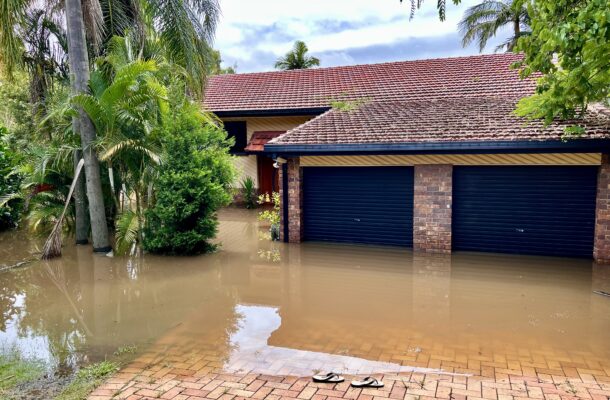The frequency of catastrophes – why accurate language matters

There it was again! Over the car radio, the ABC newsreader referred to a one-in-one-hundred year flood deriving from the recent Cyclone Kirrily in North Queensland. Or was it Cyclone Neville in the Kimberley? It doesn’t really matter; the media and the politicians love the old one-in-one-hundred year event and will attribute it wherever possible. It is not hard to imagine why – it kind of means, “phew that was a big one but don’t worry, now that it is over, it won’t be back for another one hundred years”.
I first pondered this fascination with the one-in-one-hundred year event when Covid-19 hit our shores in March 2020. The Prime Minister and many others were suggesting the pandemic was the worst such event since the Spanish Flu of 1919, hence it was a “one-in-one hundred year” event. Sorry Scott and the rest of you, that is wrong. I wrote and published the reasons why at the time. Some understanding of what the term means is needed before we drag it out in reference to any such major calamity.
Post-World War I, hydrologists and hydraulic engineers in the United States were working on various analytical tools for measuring and understanding river flow phenomena. The United States Geological Survey and the United States Army Corp of Engineers and various universities invested heavily in understanding river geomorphology, river hydraulics and catchment hydrology. The economic importance of the cities and agriculture along the Atlantic Coast, the Mid-West, the Great Plains, the Lower Mississippi and the Sacramento-San Joaquin Valley was the obvious reason for this investment. Research into flood frequency is continuing to the present day.
In that immediate post-WWI period, hydrologists developed the principles of flood frequency built around an empirical graphing technique called “the flood-frequency curve”. It worked as follows – select the maximum flood in a given year for each year on record, sort and order these floods for the period of record and finally estimate a “plotting position” for each maximum annual flood as the order of the flood divided by the number of years of record. At this point the plotting positions are graphed to produce a flood-frequency curve. What the hydrologists discovered in doing this was that the curves if produced on particular graph paper with logarithm gradation would present as “lines of best fit”. From these graphs, floods of various frequencies could be extracted.
Perhaps now is the time to introduce the relationship between return period and frequency or probability. It is that one is the inverse of the other. So, for example, a one-in-one-hundred year return period means a probability of 0.01. In lay terms this means that in any given year a one-in-one-hundred year flood has a 1% probability (i.e. likelihood) of occurring. For a one-in-twenty year flood that probability of occurring in any given year is 5%. What is particularly important about this result is that in each year, this is the probability. So, it is possible (although not probable) to have a one-in-one-hundred year flood occurring in successive years.

So far we can be comfortable with the structure of this analytical tool – the flood- frequency curve – as a practical, easy to apply empirical means for making sense of the statistics of flood data. Of course, one of the challenges is the length of available data but ways of extending the record have been found via catchment-hydraulic modelling simulation and in more recent times through the use of stochastic weather generators. Now it is time to introduce the “curve ball”, Climate Change.
Climate Change
A key assumption in the traditional use of the flood-frequency curve is that climate, over time, is following the same rules of statistical variation. That is that future climate will vary in the same way that past climate has varied. Yes I know, weather is “unpredictable” but it follows certain rules of unpredictability, which are wrapped up in the word variability. That is, that weather follows some form of distribution pattern based on the geographic and climatic peculiarities of any given locality. So, here is the killer for flood-frequency curve estimation – with Climate Change, this assumption of “consistent” variability no longer applies.
There is not one but two curve balls here. Because Climate Change is an on-going phenomenon, with the resultant “energy levels” continuing to increase as we haven’t managed to reach zero emissions of greenhouse gases (GHG), we cannot apply the traditional probability curve method without adjustment. This is a circumstance that has existed for a long time and first became noticeable in the 1970s. It is also a circumstance that will exist for hundred years or more after we reach zero GHG emissions. We are a long way from steady state when it comes to Climate Change. Of course we are a clever species and we have found a way through this via stochastic and deterministic modelling. However, this means the predictions of flood size versus frequency are increasingly more dependent on prediction rather than on actual past events – this means they are more expensive to do and have less certainty in the results.
In my paper on the likely frequency of a global pandemic I suggested that, based on preliminary observations by specialists in viral infection outbreaks, the frequency of another viral pandemic is going to be much higher than the one hundred years since the Spanish Flu outbreak. I am unaware of any sound estimate of such a frequency but it is possible that one can be made.
Similarly, we know that floods previously determined as having a frequency of one-in-one-hundred year will now, due to Climate Change, be more frequent. The inverse of this is that a one-in-one-hundred year flood will be much larger than it was in the past.
Why am I making such a meal out of this question of probability/return period estimation and how the media use a term such as the one-in-one-hundred year event? It is simply because we should desire accuracy as much as possible such that the analysis is as useful as possible. Risk from flooding or a pandemic is a combination of probability and consequence. Hence it is not just a matter of labelling a particular storm.
This risk assessment is the job of the specialists in whatever field (hydrologists and hydraulic engineers for floods and virologists and risk assessors for viral pandemics). It is not a job for daily press release writers. A key issue with this “inexpert” labelling of these catastrophes is that it gives people a false sense of security that an “event” will not return anytime soon. To the press release writers and editors of the Nation – call it a major event if you like, nothing more and nothing less.
Bernie O’Kane has a background in urban infrastructure investigation, planning, design and construction. He has worked in both the public and private sectors in Australia, Hong Kong, Malaysia, Indonesia and Vietnam, and has a Masters in environmental planning and water resources from Stanford University.















